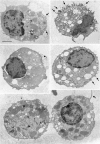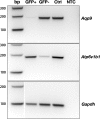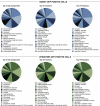Proteomic analysis of V-ATPase-rich cells harvested from the kidney and epididymis by fluorescence-activated cell sorting
- PMID: 20181927
- PMCID: PMC2889637
- DOI: 10.1152/ajpcell.00552.2009
Proteomic analysis of V-ATPase-rich cells harvested from the kidney and epididymis by fluorescence-activated cell sorting
Abstract
Proton-transporting cells are located in several tissues where they acidify the extracellular environment. These cells express the vacuolar H(+)-ATPase (V-ATPase) B1 subunit (ATP6V1B1) in their plasma membrane. We provide here a comprehensive catalog of the proteins that are expressed in these cells, after their isolation by enzymatic digestion and fluorescence-activated cell sorting (FACS) from transgenic B1-enhanced green fluorescent protein (EGFP) mice. In these mice, type A and B intercalated cells and connecting segment cells of the kidney, and narrow and clear cells of the epididymis, which all express ATP6V1B1, also express EGFP, while all other cell types are negative. The proteome of renal and epididymal EGFP-positive (EGFP(+)) cells was identified by liquid chromatography-tandem mass spectrometry (LC-MS/MS) and compared with their respective EGFP-negative (EGFP(-)) cell populations. A total of 2,297 and 1,564 proteins were detected in EGFP(+) cells from the kidney and epididymis, respectively. Out of these proteins, 202 and 178 were enriched by a factor greater than 1.5 in EGFP(+) cells compared with EGFP(-) cells, in the kidney and epididymis respectively, and included subunits of the V-ATPase (B1, a4, and A). In addition, several proteins involved in intracellular trafficking, signaling, and cytoskeletal dynamics were identified. A novel common protein that was enriched in renal and epididymal EGFP(+) cells is the progesterone receptor, which might be a potential candidate for the regulation of V-ATPase-dependent proton transport. These proteomic databases provide a framework for comprehensive future analysis of the common and distinct functions of V-ATPase-B1-expressing cells in the kidney and epididymis.
Figures






Comment in
-
Proteomics reveal the breadth and limits of model systems inferences. Focus on "proteomic analysis of V-ATPase-rich cells harvested from the kidney and epididymis by fluorescence-activated cell sorting".Am J Physiol Cell Physiol. 2010 Jun;298(6):C1303-4. doi: 10.1152/ajpcell.00091.2010. Epub 2010 Mar 17. Am J Physiol Cell Physiol. 2010. PMID: 20237146 Free PMC article. No abstract available.
Similar articles
-
Proteomics reveal the breadth and limits of model systems inferences. Focus on "proteomic analysis of V-ATPase-rich cells harvested from the kidney and epididymis by fluorescence-activated cell sorting".Am J Physiol Cell Physiol. 2010 Jun;298(6):C1303-4. doi: 10.1152/ajpcell.00091.2010. Epub 2010 Mar 17. Am J Physiol Cell Physiol. 2010. PMID: 20237146 Free PMC article. No abstract available.
-
V-ATPase B1-subunit promoter drives expression of EGFP in intercalated cells of kidney, clear cells of epididymis and airway cells of lung in transgenic mice.Am J Physiol Cell Physiol. 2005 May;288(5):C1134-44. doi: 10.1152/ajpcell.00084.2004. Epub 2005 Jan 5. Am J Physiol Cell Physiol. 2005. PMID: 15634743
-
Circulating aldosterone induces the apical accumulation of the proton pumping V-ATPase and increases proton secretion in clear cells in the caput epididymis.Am J Physiol Cell Physiol. 2013 Aug 15;305(4):C436-46. doi: 10.1152/ajpcell.00410.2012. Epub 2013 Jun 12. Am J Physiol Cell Physiol. 2013. PMID: 23761626 Free PMC article.
-
Regulation of luminal acidification by the V-ATPase.Physiology (Bethesda). 2013 Sep;28(5):318-29. doi: 10.1152/physiol.00007.2013. Physiology (Bethesda). 2013. PMID: 23997191 Free PMC article. Review.
-
H(+)V-ATPase-dependent luminal acidification in the kidney collecting duct and the epididymis/vas deferens: vesicle recycling and transcytotic pathways.J Exp Biol. 2000 Jan;203(Pt 1):137-45. doi: 10.1242/jeb.203.1.137. J Exp Biol. 2000. PMID: 10600682 Review.
Cited by
-
cSrc is necessary for epididymal development and is incorporated into sperm during epididymal transit.Dev Biol. 2012 Sep 1;369(1):43-53. doi: 10.1016/j.ydbio.2012.06.017. Epub 2012 Jun 30. Dev Biol. 2012. PMID: 22750823 Free PMC article.
-
Transgenic mice: beyond the knockout.Am J Physiol Renal Physiol. 2011 Feb;300(2):F291-300. doi: 10.1152/ajprenal.00082.2010. Epub 2010 Nov 10. Am J Physiol Renal Physiol. 2011. PMID: 21068085 Free PMC article. Review.
-
Transcriptome and Metabolome Analyses Reveal High-Altitude Adaptation Mechanism of Epididymis Sperm Maturation in Tibetan Sheep.Animals (Basel). 2024 Oct 29;14(21):3117. doi: 10.3390/ani14213117. Animals (Basel). 2024. PMID: 39518841 Free PMC article.
-
The expression patterns of aquaporin 9, vacuolar H+-ATPase, and cytokeratin 5 in the epididymis of the common vampire bat.Histochem Cell Biol. 2017 Jan;147(1):39-48. doi: 10.1007/s00418-016-1477-9. Epub 2016 Aug 22. Histochem Cell Biol. 2017. PMID: 27549752
-
New insights into the dynamic regulation of water and acid-base balance by renal epithelial cells.Am J Physiol Cell Physiol. 2012 May 15;302(10):C1421-33. doi: 10.1152/ajpcell.00085.2012. Epub 2012 Mar 28. Am J Physiol Cell Physiol. 2012. PMID: 22460710 Free PMC article. Review.
References
-
- Beaulieu V, Da Silva N, Pastor-Soler N, Brown CR, Smith PJ, Brown D, Breton S. Modulation of the actin cytoskeleton via gelsolin regulates vacuolar H+-ATPase (V-ATPase) recycling. J Biol Chem 280: 8452–8463, 2005 - PubMed
-
- Beyenbach KW, Wieczorek H. The V-type H+ ATPase: molecular structure and function, physiological roles and regulation. J Exp Biol 209: 577–589, 2006 - PubMed
-
- Bielak-Zmijewska A, Kolano A, Szczepanska K, Maleszewski M, Borsuk E. Cdc42 protein acts upstream of IQGAP1 and regulates cytokinesis in mouse oocytes and embryos. Dev Biol 322: 21–32, 2008 - PubMed
-
- Blanchard PG, Luu-The V. Differential androgen and estrogen substrates specificity in the mouse and primates type 12 17beta-hydroxysteroid dehydrogenase. J Endocrinol 194: 449–455, 2007 - PubMed
-
- Boros S, Bindels RJ, Hoenderop JG. Active Ca(2+) reabsorption in the connecting tubule. Pflügers Arch 458: 99–109, 2009 - PubMed
Publication types
MeSH terms
Substances
Grants and funding
LinkOut - more resources
Full Text Sources
Molecular Biology Databases
Research Materials

